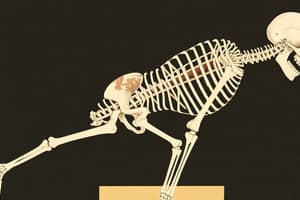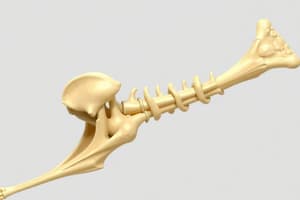Podcast
Questions and Answers
Which of the following is NOT a primary function of the skeletal system?
Which of the following is NOT a primary function of the skeletal system?
- Production of hormones that regulate growth. (correct)
- Support for the body.
- Attachment point for muscles, enabling movement.
- Protection of vital organs.
What is the primary event that occurs during intramembranous ossification?
What is the primary event that occurs during intramembranous ossification?
- Spongy bone is produced directly by osteoblasts within a fibrous connective tissue membrane. (correct)
- Hyaline cartilage model is formed, which then ossifies.
- Cartilage is gradually replaced by bone tissue.
- Osteoclasts break down existing bone to remodel the structure.
During endochondral ossification, what role do the epiphyseal plates play?
During endochondral ossification, what role do the epiphyseal plates play?
- They facilitate the widening of the bone.
- They are the primary site of bone remodeling throughout life.
- They are responsible for the formation of the medullary cavity.
- They contribute to bone growth in length. (correct)
How does moderate mechanical stress, like exercise, affect bone remodeling?
How does moderate mechanical stress, like exercise, affect bone remodeling?
Which of the following best describes the role of Vitamin D in bone growth and remodeling?
Which of the following best describes the role of Vitamin D in bone growth and remodeling?
What is the effect of calcitonin on bone metabolism?
What is the effect of calcitonin on bone metabolism?
Which of the following is a key step in bone repair after a fracture that involves the formation of a 'soft callus'?
Which of the following is a key step in bone repair after a fracture that involves the formation of a 'soft callus'?
Why are casts often required for bone fractures?
Why are casts often required for bone fractures?
What role do osteoclasts play in bone remodeling?
What role do osteoclasts play in bone remodeling?
What is appositional growth in bones?
What is appositional growth in bones?
What is the role of red bone marrow in the skeletal system?
What is the role of red bone marrow in the skeletal system?
Which hormone directly increases bone resorption by increasing osteoclast activity?
Which hormone directly increases bone resorption by increasing osteoclast activity?
What is a key characteristic of osteoporosis?
What is a key characteristic of osteoporosis?
Which of the listed factors contributes to the development of osteoporosis?
Which of the listed factors contributes to the development of osteoporosis?
When does bone ossification typically terminate in males?
When does bone ossification typically terminate in males?
During bone repair, what is the composition of the callus that replaces the initial blood clot?
During bone repair, what is the composition of the callus that replaces the initial blood clot?
Which of the following is required for collagen production in bones?
Which of the following is required for collagen production in bones?
What is the direct effect of estrogen and testosterone on bone remodeling?
What is the direct effect of estrogen and testosterone on bone remodeling?
What is the result of a vitamin D deficiency in bone development?
What is the result of a vitamin D deficiency in bone development?
What specific process is impacted by drugs, such as cortisone and alcohol, in relation to bone growth?
What specific process is impacted by drugs, such as cortisone and alcohol, in relation to bone growth?
Flashcards
Skeletal System Functions
Skeletal System Functions
Includes support, protection of vital organs, muscle attachment for movement, red bone marrow producing blood cells, calcium storage, and fat storage in yellow bone marrow.
Bone Ossification
Bone Ossification
Begins around the 8th week of development and finishes around age 18 in females and 21 in males.
Intramembranous Ossification
Intramembranous Ossification
Flat bones of the skull, some facial bones, the mandible, and parts of the clavicle develop directly from fibrous connective tissue.
Endochondral Ossification
Endochondral Ossification
Signup and view all the flashcards
Epiphyseal Plates
Epiphyseal Plates
Signup and view all the flashcards
Appositional Bone Growth
Appositional Bone Growth
Signup and view all the flashcards
Mechanical Stress on Bone
Mechanical Stress on Bone
Signup and view all the flashcards
Growth Hormone
Growth Hormone
Signup and view all the flashcards
Estrogen and Testosterone
Estrogen and Testosterone
Signup and view all the flashcards
Calcitonin
Calcitonin
Signup and view all the flashcards
Parathyroid Hormone
Parathyroid Hormone
Signup and view all the flashcards
Osteoporosis
Osteoporosis
Signup and view all the flashcards
Bone Repair Process
Bone Repair Process
Signup and view all the flashcards
Fracture Repair - Callus
Fracture Repair - Callus
Signup and view all the flashcards
Bone Remodeling
Bone Remodeling
Signup and view all the flashcards
Nutrition for Bone Growth
Nutrition for Bone Growth
Signup and view all the flashcards
Study Notes
- Functions of the skeletal system include support, protection of vital organs, muscle attachment for movement.
- Red bone marrow produces red blood cells (RBCs), white blood cells (WBCs), and platelets.
- The skeletal system stores calcium and performs fat storage in yellow bone marrow.
Ossification
- Bone ossification starts during the 8th week of development and ends at 18 years in females, 21 years in males.
Intramembranous Ossification
- Flat bones of the skull, some facial bones, the mandible and clavicle form through intramembranous ossification.
- This process develops from fibrous connective tissue membrane.
- Osteoblasts create spongy bone along fibers.
- The periosteum forms, and osteoblasts underneath create compact bone.
- Fontanels are unossified membranes that remain in the skull at birth.
Endochondral Ossification
- Most bones develop from hyaline cartilage.
- Cartilage is laid down as the rough shape of the bone.
- Cartilage ossifies into spongy bone.
- Periosteum forms, and osteoblasts beneath deposit compact bone.
- Articular cartilage and epiphyseal plates are cartilage that is not ossified.
Post-Natal Bone Growth
- Endochondral growth happens at the epiphyseal plates, facilitating growth in length.
- Cartilage grows, and the matrix near the diaphysis transforms into bone.
- Growth in length ceases as the epiphyseal plate ossifies into the epiphyseal line.
- Appositional growth increases bone diameter.
- Osteoblasts beneath the periosteum of long bones facilitates growth in diameter.
- Osteoclasts in the medullary endosteum resorb bone, ensuring cavity size matches bone growth.
Factors Affecting Bone Growth and Remodeling
- Bone growth and remodeling are mechanically influenced
- Moderate exercise increases osteoblast activity in stressed areas, favoring building over breakdown.
- Injury restricts movement, diminishing osteoblast activity without altering osteoclast activity, which decreases bone mass.
- Weights/electrical currents potentially accelerate osteoblast activity.
- Calcium and phosphorus are crucial for bone matrix production.
- Vitamin C is essential for collagen production.
- Vitamin D is required for small intestine calcium absorption; deficiency leads to soft bones, known as rickets.
- Growth hormone, thyroid hormone, insulin, estrogen, and testosterone stimulate bone growth.
- Estrogen and testosterone increase osteoblast activity.
- Estrogen hastens epiphyseal plate ossification, affecting both sexes but earlier in females due to higher estrogen.
- Calcitonin inhibits osteoclast activity, promoting calcium movement from blood to bone.
- Parathyroid hormone raises blood calcium by increasing bone resorption through osteoclast activity.
Osteoporosis
- Osteoporosis involves a decrease in bone mass.
- Risk factors include aging, inadequate vitamin D and calcium intake, excess parathyroid hormone, and insufficient/excessive exercise.
- Low body fat and high stress (cortisol) contribute.
- Menopause in females, marked by estrogen decline, reduces osteoblast and increases osteoclast activity.
- Smoking diminishes estrogen levels.
- Drugs like cortisone and alcohol lower osteoblast activity.
Bone Repair
- Fracture repair begins with a blood clot.
- The clot transforms into a callus consisting of a fibrous collagen network and fibrocartilage islets.
- Callus then ossifies through intramembranous and endochondral ossification.
- Spongy bone is then replaced by compact bone around the fracture site.
- Osteoclasts resorb dead bone, and the process takes 4-6 weeks (longer for larger bones).
- Casting is needed, where movement can refracture the forming matrix.
Studying That Suits You
Use AI to generate personalized quizzes and flashcards to suit your learning preferences.




